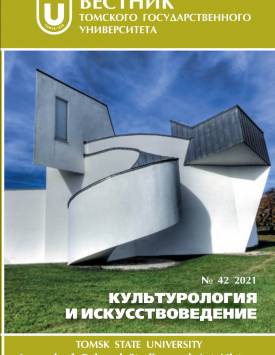The evolution of the forms of shandong province's stone reliefs composition of the Han era
The stone reliefs of the Han era (206 BC - 220 AD) are a special type of funerary art with its own specific set of plots and art forms. Shandong Province takes the first place in China in terms of number of founding relief images. The peculiarity of the compositional construction of the Han's reliefs is that it isn't based on the spatial principle of image transmission, but on the plastic-planar pictorial principle of a two-dimensional composition, which, with its thoughtful use, can carry the maximum emotional charge [Moshkov, Kuznetsov 1994]. Based on that, author's own typology of the compositions of Han reliefs was built. Article the object of the study are stone reliefs of the Han Dynasty, Shandong Province, represented on stone sarcophagi, in stone tombs, temples of ancestors and steles, and passed the past two stages of its heyday. The purpose and objective of the study is to identify and study the laws of evolution of the composition of the stone reliefs of the Han Dynasty, Shandong Province, based on V.M. Moshkova's principles of composition, using systemic and iconological research methods. Images on the stone reliefs of the Han tombs are distinguished by the peculiarity of the forms of compositional constructions, the process of development and evolution of which occurs in accordance with certain laws. As a result of the study, it was revealed that the starting point for the development of relief compositions of stone sarcophagi were two forms - symmetrical and nested (including several levels following the outlines and forms of stone material), which during the heyday of the Western Han Dynasty supplemented the “V”-shaped composition. Their further development is associated with the use of dispersed, zoned, irregular composition techniques, which spread around in turn of the CE. At the same time, a variety of compositional forms is also observed in the reliefs of tombs, temples of ancestors and stelae, in the reliefs of which during the period of the Eastern Han (25-220 CE) many different forms of compositional organization appear: for example, asymmetric, segmented, shingles wrong etc. The composition of combinations of geometric shapes, consisting, as a rule, of squares and circles, is also distributed. A variety of compositional forms is associated, on the one hand, with the complication of the architecture of burial structures and an increase in their scale. On the other hand, with the enrichment of the content and plots of reliefs, which is becoming more diverse and includes not only the image of Confucian's symbols, but also narratives that reflect episodes from the lives of those buried. This indicates not only the process of improving art forms during the Han era, but also reflects a certain evolution of religious and philosophical thought, changes that took place in this period in the social structure of ancient Chinese society, and also, possibly, some external influences on the development of Chinese art.
Keywords
significance, composition, classification, Shandong Province, stone relief of Han eraAuthors
| Name | Organization | |
| Bi Zhicheng | Saint Petersburg Stieglitz State Academy of Art and Design; Harbin University of Science and Technology | 835827891@qq.com |
References

The evolution of the forms of shandong province's stone reliefs composition of the Han era | Tomsk State University Journal of Cultural Studies and Art History. 2021. № 42. DOI: 10.17223/22220836/42/2
